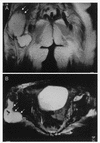Analysis of a viridans group strain reveals a case of bacteremia due to lancefield group G alpha-hemolytic Streptococcus dysgalactiae subsp equisimilis in a patient with pyomyositis and reactive arthritis
- PMID: 12574255
- PMCID: PMC149685
- DOI: 10.1128/JCM.41.2.613-618.2003
Analysis of a viridans group strain reveals a case of bacteremia due to lancefield group G alpha-hemolytic Streptococcus dysgalactiae subsp equisimilis in a patient with pyomyositis and reactive arthritis
Abstract
Streptococcus dysgalactiae is classified by a combination of phenotypic and genotypic characteristics into Lancefield group C alpha-hemolytic Streptococcus dysgalactiae subsp. dysgalactiae and Lancefield group C, group G, and group L beta-hemolytic Streptococcus dysgalactiae subsp. equisimilis. In this study, we report the isolation of a catalase-negative, alpha-hemolytic, optochin- and bacitracin-resistant viridans group strain, which does not grow in 10 or 40% bile, on MacConkey agar or bile esculin agar, or in 6% NaCl, from the blood culture of a 73-year-old woman with pyomyositis and poststreptococcal reactive arthritis. Lancefield grouping revealed that the strain was a group G streptococcus. The Vitek system (GPI) showed that it was unidentified, and the API system (20 STREP) showed that it was 95.7% S. dysgalactiae subsp. dysgalactiae. 16S rRNA gene sequencing showed that it was a strain of S. dysgalactiae. Based on phylogenetic affiliation with 16S rRNA gene or GroEL amino acid (another bacterial gene, in addition to 16S rRNA gene, that is highly conserved) sequences, the strain is most closely related to Lancefield group C beta-hemolytic S. dysgalactiae subsp. equisimilis. PCR amplification and sequencing of the streptolysin S structural gene (sagA) and M protein gene (emm) hypervariable region showed the presence of these suspected primary virulence factors. Further studies would delineate whether the isolate is just a hemolysin-deficient variant of group G beta-hemolytic S. dysgalactiae subsp. equisimilis or a novel type of S. dysgalactiae. The present case showed that group G alpha-hemolytic S. dysgalactiae subsp. equisimilis can be associated with serious invasive infection and poststreptococcal sequelae.
Figures


Similar articles
-
Genetic relationships deduced from emm and multilocus sequence typing of invasive Streptococcus dysgalactiae subsp. equisimilis and S. canis recovered from isolates collected in the United States.J Clin Microbiol. 2009 Jul;47(7):2046-54. doi: 10.1128/JCM.00246-09. Epub 2009 Apr 22. J Clin Microbiol. 2009. PMID: 19386831 Free PMC article.
-
Group G beta-hemolytic streptococcal bacteremia characterized by 16S ribosomal RNA gene sequencing.J Clin Microbiol. 2001 Sep;39(9):3147-55. doi: 10.1128/JCM.39.9.3147-3155.2001. J Clin Microbiol. 2001. PMID: 11526143 Free PMC article.
-
Distribution of virulence factors and association with emm polymorphism or isolation site among beta-hemolytic group G Streptococcus dysgalactiae subspecies equisimilis.APMIS. 2015 Jan;123(1):45-52. doi: 10.1111/apm.12305. Epub 2014 Sep 22. APMIS. 2015. PMID: 25244428
-
Streptococcus dysgalactiae subsp. equisimilis bacteremia: an emerging infection.Eur J Clin Microbiol Infect Dis. 2014 Aug;33(8):1303-10. doi: 10.1007/s10096-014-2092-0. Epub 2014 Mar 29. Eur J Clin Microbiol Infect Dis. 2014. PMID: 24682845 Review.
-
Intra-familial transmission of Streptococcus dysgalactiae subsp. equisimilis (SDSE): A first case report and review of the literature.J Infect Chemother. 2022 Jun;28(6):819-822. doi: 10.1016/j.jiac.2022.01.017. Epub 2022 Feb 1. J Infect Chemother. 2022. PMID: 35115237 Review.
Cited by
-
Fibronectin-binding protein gene recombination and horizontal transfer between group A and G streptococci.J Clin Microbiol. 2004 Nov;42(11):5357-61. doi: 10.1128/JCM.42.11.5357-5361.2004. J Clin Microbiol. 2004. PMID: 15528742 Free PMC article.
-
Streptococcosis a Re-Emerging Disease in Aquaculture: Significance and Phytotherapy.Animals (Basel). 2022 Sep 16;12(18):2443. doi: 10.3390/ani12182443. Animals (Basel). 2022. PMID: 36139303 Free PMC article. Review.
-
Automated identification of medically important bacteria by 16S rRNA gene sequencing using a novel comprehensive database, 16SpathDB.J Clin Microbiol. 2011 May;49(5):1799-809. doi: 10.1128/JCM.02350-10. Epub 2011 Mar 9. J Clin Microbiol. 2011. PMID: 21389154 Free PMC article.
-
Group G streptococcal sepsis, septic arthritis and myositis in a patient with severe oral ulcerations.BMJ Case Rep. 2014 Jan 27;2014:bcr2013200338. doi: 10.1136/bcr-2013-200338. BMJ Case Rep. 2014. PMID: 24469838 Free PMC article.
-
Usefulness of the MicroSeq 500 16S ribosomal DNA-based bacterial identification system for identification of clinically significant bacterial isolates with ambiguous biochemical profiles.J Clin Microbiol. 2003 May;41(5):1996-2001. doi: 10.1128/JCM.41.5.1996-2001.2003. J Clin Microbiol. 2003. PMID: 12734240 Free PMC article.
References
-
- Ayoub, E. M., and H. A. Majeed. 2000. Postreptococcal reactive arthritis. Curr. Opin. Rheumatol. 12:306-310. - PubMed
-
- Breed, R. S., E. G. D. Murray, and A. P. Hitchens. 1948. Manual of determinative bacteriology, 6th ed., p. 318-319. Williams and Wilkins, Baltimore, Md.
-
- Cheuk, W., P. C. Y. Woo, K. Y. Yuen, P. H. Yu, and J. K. C. Chan. 2001. Intestinal inflammatory pseudotumor with regional lymph node involvement: identification of a new bacterium as the etiologic agent. J. Pathol. 192:289-292. - PubMed
-
- Dierksen, K. P., and J. R. Tagg. 2000. Haemolysin-deficient variants of Streptococcus pyogenes and S. dysgalactiae subsp. equisimilis may be overlooked as aetiological agents of pharyngitis. J. Med. Microbiol. 49:811-816. - PubMed
-
- Frost, W. D., and M. A. Engelbrecht. 1940. The streptococci. Willdorf Book Co., Madison, Wis.
Publication types
MeSH terms
Substances
LinkOut - more resources
Full Text Sources
Molecular Biology Databases
Research Materials

